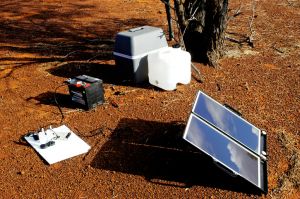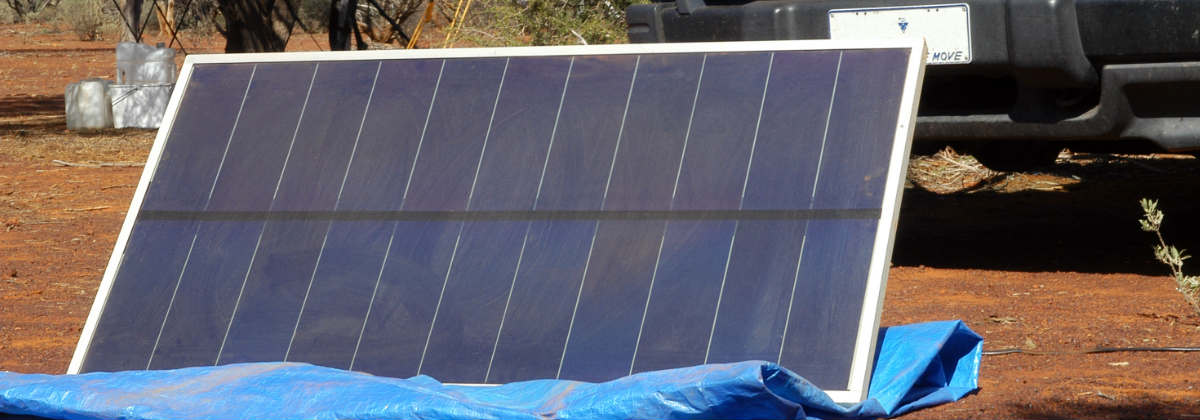Portable solar panels are great for camping, boating and caravanning. Solar is self-sufficient, quiet, and best of all, it’s free – at least after you buy the panels. But don’t fall into the trap of thinking that all solar panels are the same. If you don’t want to be left in the dark on your next outdoor adventure, you need to know what portable solar panels are right for your needs.
On this page:
Advertisement
Types of portable solar panels
There are three types of solar panels:

- Monocrystalline: These are highly efficient panels capable of charging batteries and powering a number of small appliances. Solar panels can either come in traditional glass tiles, or built into convenient, foldable blankets (pictured right).
- Polycrystalline: These are generally weak panels with low voltage, however they operate better in low light and are cheaper than Monocrystalline panels. Polycrystalline panels charge batteries slowly, so they shouldn’t be relied on as a sole source of power for mid or high consumption appliances. Once again, these panels can be bought in solar blanket or standard tile form.
- Amorphous (thin film): This is a flexible film of photovoltaic cells that can be rolled, bent and folded. Generally, the more flexible the system is, the less efficient it will be. Thin film panels produce very low amounts of electricity and aren’t too popular as a result.
Portable solar panels for camping
If you’re an essentials-style camper and you only need electricity to say, charge your phone, or run an LED light or two, then a cheap polycrystalline system or amorphous film mat should work fine. If you need a portable solar system that can do a little more heavy lifting, such as power a car-fridge or even a small TV, then you’re in the market for a stronger monocrystalline system.
Portable solar panels for boats
There’s usually not much open space to lay amorphous solar mats on a boat, so you will need fixed panels attached to either the roof or the rear of the boat. As solar power is the only reliable source of electricity out on the high seas, you will want to play it safe with a quality set of monocrystalline panels.
Portable solar panels for caravans
Fixing solar panels to the roof of your vehicle means you’re collecting solar power wherever you go. If you have a car fridge or any other high-consumption vehicle appliances, then a set of monocrystalline panels is the way to go. On the other hand, if you simply want solar to keep a jump-start kit charged, then a polycrystalline set will work fine.
You might also be interested in:
Best portable solar panels
The ‘best’ portable solar panels are of course somewhat subjective and depend on what you prefer. For example, some of the tougher solar panels built for the harshest of Australia’s climates might not be as efficient or cost-effective as more delicate models. So instead, we’ve listed below some popular portable solar panel brands to help start you on your way:
- Bluetti
- EcoFlow
- Enerdrive
- Goal Zero
- Hardkorr
- Kings
- Powertech
- Redarc
- Renogy
- Wanderer
- XTM
There are plenty other portable solar panel brands in the market, but these are a good place to start. Most brands listed produce an array of solar systems across various types and sizes.

What size portable solar panels should I buy?
The portable solar panel size you need will depend largely on what it is you are trying to power on your campsite or remote location and the total wattage of all these devices combined.
For example, if you are simply trying to charge some devices and power some lamps, you’ll only need a limited amount of solar power when compared to powering a camping fridge, heating and cooling set-up and electric cooking appliances.
To give yourself a rough outline, look at the watts of your appliances and devices, add them together and then compare it to the portable solar panel options available to you. It may also help to consider whether you’ll need a portable solar battery for additional power later on. This might come in handy if you are trying to power numerous appliances or find yourself without a power source for a portion of time (e.g. overcast days).
Portable solar panel prices
A portable monocrystalline solar system costs between $200 and $800 on average. Small portable solar panels for charging phones and other handheld appliances will only cost between $30 and $100. Solar blankets can cost anywhere from $350 to $700, depending on size, model and any gimmicky features. A portable deep-cycle solar battery hurts the budget the most, pricing anywhere between $300 and $1,000.
Also be sure to factor in the costs for add-ons that may or may not be necessary for your particular system. This includes battery isolators and relays, connectors, inverters, monitors, regulators, fuse blocks and adapters. These can set you back a few hundred dollars as well.
Compare Solar Plans
Here are some of the cheapest solar-specific deals from the retailers on our database. These costs are based on the Ausgrid network in Sydney but prices will vary depending on your circumstances. We show one product per retailer, listed in order of lowest price first. Annual price estimates assume general energy usage of 3900kWh/year for a residential customer on a single rate tariff. Price estimates exclude solar feed-in tariff credits. These are products from referral partners†. Our database may not cover all deals in your area, and please check retailer websites for up to date information.
Here are some of the cheapest solar-specific deals from the retailers on our database. These costs are based on the Citipower network in Melbourne but prices will vary depending on your circumstances. We show one product per retailer, listed in order of lowest price first. Annual price estimates assume general energy usage of 4000kWh/year for a residential customer on a single rate tariff. Price estimates exclude solar feed-in tariff credits. These are products from referral partners†. Our database may not cover all deals in your area, and please check retailer websites for up to date information.
Here are some of the cheapest solar-specific deals from the retailers on our database. These costs are based on the Energex network in Brisbane but prices will vary depending on your circumstances. We show one product per retailer, listed in order of lowest price first. Annual price estimates assume general energy usage of 4600kWh/year for a residential customer on a single rate tariff. Price estimates exclude solar feed-in tariff credits. These are products from referral partners†. Our database may not cover all deals in your area, and please check retailer websites for up to date information.
Here are some of the cheapest solar-specific deals from the retailers on our database. These costs are based on SA Power network in Adelaide but prices will vary depending on your circumstances. We show one product per retailer, listed in order of lowest price first. Annual price estimates assume general energy usage of 4000kWh/year for a residential customer on a single rate tariff. Price estimates exclude solar feed-in tariff credits. These are products from referral partners†. Our database may not cover all deals in your area, and please check retailer websites for up to date information.
How to look after your portable solar panels
Unfortunately, portable solar panels and their components wear out. After about two or three years, you will begin noticing degradation in the power output of your system. By the time you reach eight or more years, your portable solar kit will likely not be as useful anymore. So what can you do?
You can’t reverse the natural process of aging, but you can slow it. Portable solar panels are particularly temperamental in producing electricity, quickly wearing out your system. To prevent this, don’t skimp out on add-ons designed to protect your setup, such as solar power regulators, portable fuse boxes and boards. Proper care and maintenance of your solar system can add years to the performance of your solar system, saving you hundreds of dollars.
Original Author: Brendon O’Neill




Share this article